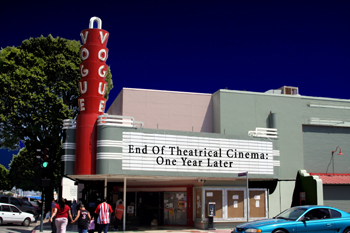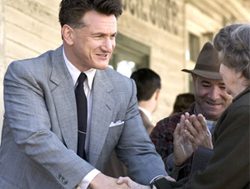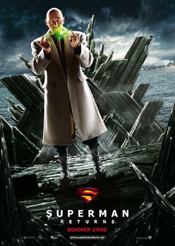Making movies. Enjoying movies. Remembering movies.
THE SCREENING ROOM
Related Articles:
More Articles by Rick
Mitchell
|
By Rick Mitchell

Because 2006 turned out to be slightly better boxoffice-wise than 2005, the industry has apparently put off dealing with the issues brought out in discussions about last year’s decline in attendance, especially among the 30-50 year old demographic, and particularly the reasons for that decline that were emphasized in interviews and letters to editors from the general public. And yet, an incident occurred two months ago that suggests there are still reasons for concern: the surprising failure of “All The King’s Men.”
 |
Not that this film was expected to
be a boxoffice bonanza, but over the last five years, films with its
profile and release pattern have usually opened at between $10 and
$20,000,000; “King’s” opened at only $3,500.000! Now, this failure may
have been due to specific reasons related to the film itself, which I’ll
get into later, but, in light of things brought out last year, it has
ominous portentions regarding the future regular attendance of the over
30-year-old segment of the audience that really need to be considered
now in making future production choices.
“King’s” was supposed to kick off the Fall “serious, adult” film season.
As I pointed out last year, this
segment of the audience is normally defined monolithically, but
discussion of it is actually limited to liberal arts college-educated
persons generally reflective of the backgrounds of most studio
executives, producers, and critics. And the actual commercial importance
of this segment of the audience has been blown out of proportion by the
emphasis on arthouse/festival films which supposedly are especially
appealing to them over the last 15 years, even by previously
traditionally oriented publications like Variety and Boxoffice. Yet,
though vocal members of this audience claim to want more “serious adult”
films, when such films are made, they rarely show up in theaters in
sufficient numbers to justify the film’s distribution, much less
production, costs. Why? It was put best by the author of a letter to the
Los Angeles Times in response to the only story I’ve seen so far on the
“King’s” affair:
| THE film’s failure
should not be a surprise to [director Steve] Zaillian. Audiences are
now going out to movie theaters to see four distinct genres: event
blockbusters (based on comic books, video games, etc), family film,
horror pictures, and broad comedies. TV has now become the premiere
platform for adult dramas. [Emphasis mine] The sooner the people who
made “All The King’s Men,” “Hollywoodland” and “The Black Dahlia”
learn this, the better it will be for everyone, especially the
people who foot the bill. It is a youth market. [Again emphasis
mine] What was considered lowbrow in the ’70s and ’80s is now what
is keeping the studios alive. Look at what happened to this summer’s
“adult drama” version of “Miami Vice.” Universal could have had a
smash hit and a big franchise had it made the youth friendly/action
version and booted MichaeI Mann. Peter Rogers Valencia |
It is a youth market, and really
has been for the last sixty years. As I pointed out last year, the loss
in the 30-60 demographic began back then because adults in this age
group had demands on their free time that weren’t as prominent during
the Depression and World War II: starting families, advancing careers,
and in 1947, going to college to a higher degree than at any time
previously. TV was not as big an initial factor as often claimed; it’s
constantly forgotten that there weren’t that many stations broadcasting
in 1947 and only the really affluent, like people in the upper echelons
of the industry, could afford sets. TV did become an increasing
alternative to theatrical moviegoing for them through the Fifties and
the increased availability on TV of new theatrical releases after 1960,
from a delay of five years down to as little as three months today,
reduced the inducement to see films in a theater. Plus, the targeted
portion of this particular demographic also has the money for high end
home theater setups, and find staying at home and using them preferable
to the negatives to theatergoing most frequently cited last year:
parking hassles, long lines at ticket windows and concession stands, and
obnoxious audiences.
There was a precipitous decline in what was left of the post-World War
II “adult” audience after 1965, though it had a brief renaissance in
1972-73. Now the “boomers” who then sustained the theatrical industry
are drifting away. Given that the subject matter of most “adult” films
is of little interest even to those in their early Twenties, if
“boomers” are preferring their home theaters to multiplexes in greater
numbers today than over the last five years, production executives need
to start seriously considering the advisability of making films for
theatrical release which have no appeal to the 15-24 year old audience;
the current hit “The Departed” is an example of a film that does appeal
to both demographics. And, as has been proven so often of late, “stars”
mean nothing, neither do reviews, or even Oscars when it comes to that
home vs. theater decision among those over 30. DVD and home theater are
now so ingrained into their sensibility that it takes a really special
combination of elements to get them into theaters even during those
periods of the year in which they’ve been proven likely to go in the
past: late July and August, Thanksgiving weekend, and the week between
Christmas and New Years.
At the same time, it’s worth noting that there is nothing about most of
these “adult” films, except maybe for comedies, that really demands
their being seen in a theater. Mostly dialog driven, they play just as
well, if not better on the tube, especially contemporary films done
almost entirely in tight long lens close-ups with nothing really to look
at but often unattractive faces.
As I write this, the only other current film with a comparable audience
profile to that of “All The King’s Men” is “Flags Of Our Fathers,”
possibly the year’s best film, but also doing what is considered poor
business. There are those who say this is typical of Eastwood’s films,
both “Mystic River” and “Million Dollar Baby” started off slow and built
gradually, but neither of those films had the advance expectations of
“Flags."
 |
Both films do have the problem of being period pictures, “King’s” in
particular set in a period that has never been particularly popular, the
decade right after the end of World War II. “The Black Dahlia” also has
this problem as well as being a story more of interest in L.A. than the
rest of the country, despite the success of the book; remember you’re
talking about two different segments of popular culture.
“King’s” also suffers from the miscasting of Sean Penn. The
repercussions of his politics aside, only in the culturally clueless
executive suites of contemporary Hollywood would a lightweight like Penn
be seriously considered for the role of a stereotypically tough loud
populist mid-20th Century Southern politician. Matthew McConaughy maybe
today; Gene Hackman, Kris Kristofferson, or Burt Reynolds thirty years
ago, but Sean Penn? Of course, in the film he makes it work, thanks to
first being seen as the innocent lamb who discovers he’s being led to a
political slaughter just in time to turn the tables. But this transition
is not included in the film’s trailers and media spots and heard out of
context, Penn’s whiney rantings in that Senator Claghorn accent could
have been a turnoff to potential moviegoers who weren’t bothered by his
politics. It is tragic when audiences typecast performers and won’t
readily accept them doing something different, but the effect of
audience perception of a particular performer does need to be considered
in casting decisions, especially in films aimed at older audiences who
are often more performer conscious.
Do I have suggestions for a solution? The same one I made last year:
rather than trying to make the theatrical moviegoing experience more
home theater-like, do the opposite and promise a unique experience that
cannot be duplicated in the home. Things look promising, now that
exhibitors seem to have finally gotten out of the shoebox mini-theater
mindset. But “letterboxing” 2.40:1 images within a screen set up for
1.85:1, comparable to the approach taken in video, is not the way to go
here.
And there needs to be serious consideration of the end result from the
production end. A friend of mine is an exponent of what he calls
“experiential cinema,” that is using the technical resources of the film
medium, wide screen, stereophonic sound, even 3-D, to create that unique
theatrical moviegoing experience. This was done regularly in the silent
days, especially in big city movie palaces in the Twenties. In fact,
according to historian Robert Gitt, the Warner Bros. and William Fox’s
interest in sound was not in “talking pictures” but in bringing the full
orchestra played musical scores and sound effects normally used in those
palaces to smaller houses in less culturally affluent areas of the
country. The introduction of the “Talkies” did decrease interest in some
of these gimmicks for about 25 years, but they underwent a major
revival, with a fair amount of commercial success, between 1952 and
1970.
Ironically, what killed serious interest in this aspect of film viewing
was the increased interest in film of academic institutions and the
equally increasing influence of critics, all of whom looked down their
noses at the “Barnum & Bailey” aspects of Hollywood. To them, “cinema”
should just be a bastardized form of stage drama. This attitude is still
found today in the gushing reviews of “serious adult” films which have
orgasms over essentially the recording of actors delivering dialog with
no consideration, or apparent awareness, of the role production design,
cinematography, picture and sound editing, music, and re-recording have
had on the end result and could have had to a greater degree if the
filmmakers were as aware of their potential as Hitchcock, Ford, Stevens,
Wilder, etc. were, and only Eastwood and Scorcese of today’s regularly
working directors seem to be. Both “The Departed” and “Flags Of Our
Fathers” play beautifully on big wide screens the way even wide screen B
films from the Fifties and Sixties still do but most contemporary
megabuck attempts at epics don’t.
“Experiential Cinema” will require a different mindset than that held by
most contemporary filmmakers. Even before the wide screen era, films,
even Bs were shot with the idea of being seen on big screens. Today,
filmmakers shooting on film rarely see a print on even a medium sized
screen until they see the answer print. Plus, the majority of these
filmmakers are from a small screen video background and are used to
watching scenes as they’re shot on a video monitor. Few of them have a
“big screen eye.” Angeleno film buffs of my acquaintance with the latest
home theater systems still turn out for local revivals of Cinerama and
70mm films from the Fifties and Sixties because, as they admit, their
home systems cannot compete with the presentation of these films on the
screens of the Cinerama Dome, LACMA, or the Academy or American
Cinematheque’s theaters.
 |
Unfortunately few contemporary moviegoers have seen such presentations,
although those who’ve taken the opportunity to do so are impressed, but
generally they have no problem accepting such underwhelming contemporary
attempts as the “Pirates Of The Caribbean” films, “Superman Returns”
(for which 65mm was originally considered!), or the Peter Jackson
version of “King Kong.” Equally unfortunately, the industry’s executive
maroons are more likely to hand an exploratory 65mm or serious 3-D
project over to the likes of Michael Bay, Rob Cohen, or Renny Harlin,
who should never even be let near even a home video camera, rather than
say, John Carpenter, Wes Craven, Joe Dante, or Richard Donner
(diplomatically billed alphabetically), who’ve proven they can deliver
the goods on such a project, especially when allowed creative freedom,
and with the first three, economically, too; Steven Soderbergh and
Robert Rodriguez, who¹s already proven his ability with 3-D, would also
likely do something interesting if offbeat.
Of course, every film can’t be an exercise in Experiential Cinema,
probably not even one every month. It should be recalled that what
ultimately killed the roadshow era of the Sixties was a surfeit of such
films, eight in 1965 for example, plus the inflating to roadshow status
of films like “Ice Station Zebra” and “MacKenna’s Gold” that really
weren’t “unique and special” in the manner of the standard-setters like
“Around The World In Eighty Days,” “The Ten Commandments,” “Ben-Hur,”
“Lawrence Of Arabia,” and “The Sound Of Music.” The first experiential
film subject needs to be seriously considered in light of the tastes of
the 15-24 demographic as well as older audiences, lest the mistake made
in the Nineties with “Far And Away” and “Hamlet” be repeated. (Even with
the quality of CGI effects being debatable, “Speed,” “Independence Day,”
or “Titanic” would have been better choices for a revival of 65mm
production.)
Where does Imax fit into this? In my opinion, nowhere. Admittedly, I’m
one of the few people who’ve never been impressed by Imax, considering
it another verification of Barnum’s famous dictum. Aside from the
technical problems of original dramatic production in 15 perf. Imax, the
size and shape of the image really does not lend itself to the cinematic
narrative techniques that have evolved over the last hundred years, and
most audiences would find an Imax film done in today’s tight closeup
long lens style to be unwatchable, especially if also shot primarily
with a handheld camera. It has always amused me that the dramatic films
repurposed for Imax have been matted down to a rectangular shape,
including the anamorphic “Batman Begins” and “Superman Returns” rendered
at 2.40:1, which is the antithesis of the idea of Imax
And it would be a mistake to reduce the number of films released
annually, as some, especially critics, have suggested. Depending on his
share of the local market, an exhibitor needs to put something new on
his screen every two weeks at the minimum, every week in a multiscreen
situation. He has to consider not only the potential patron who may not
want or is unable to attend the first week, but the one who did and may
not want to see it again the next week. And the bulk of these films have
to primarily appeal to that 15-24 year old demographic because, even
though their attendance figures are also declining, they are still more
likely to go to theaters than older people. This doesn't necessarily
mean an annual indundation of “Jackasses” and “Saws.” The surprisingly
success of the very cerebral “The Prestige” suggests that there is hope
for carefully considered but non-patronizing intelligent fare aimed at
this group.
And, given the complaints about high prices last year, which industry
types naturally ignored, the consequences of the recently announced plan
to charge $25 for “Dreamgirls” in its exclusive run at the Cinerama Dome
in Los Angeles, the Ziegfeld in New York and the Metreon in San
Francisco probably should be seriously thought out. It may be a
“toe-in-the-water” test of the revival of roadshow-type production and
presentation, of which Steven Spielberg was a fan, and for which a price
increase may be necessary for the implementation of certain experiential
cinema technologies, but it will only work if audiences feel the film
and the technology are worth the additional cost, as they did in the
early days of roadshowing in the Fifties. Though locally, the ArcLight,
Bridge, El Capitan, and Grove appear to have been successful with such
aspects of roadshowing as higher prices and reserved seats, the regular
audience at these theaters are exclusively well-heeled Westside
trendoids, less affluent film buffs who live near them being unable to
afford to attend on even a regular basis, and I have not heard of such
techniques succeeding or even being tried in other parts of town or the
country, with the possible exception of equally trendy Manhattan.
There is really nothing about “Dreamgirls” or its presentation to make
the higher price seem worth it to the majority of potential moviegoers.
On the surface it appears to be nothing more than a megabuck remake of
“Sparkle” (1976). Yes, the show has name recognition. So did “The Wiz,”
“The Phantom Of The Opera,” and “Rent.” Most theater fans consider film
versions to be inferior to stage versions, especially of musicals. And
there is a generation gap issue here, even with black audiences. But,
like the public embrace of repurposed films in Imax, the hype equating a
higher admission price with something special, even if it really isn’t,
may be enough to get a sufficient number of trendoids in to allow
Paramount and Dreamworks to claim the price increase was a success and
they or other distributors to try it with another film, probably a $300
mil+ presumed sure thing that turns out not to be.
 |
The future of theatrical filmgoing is more in the hands of the boards of
directors of the conglomerates who own the production and distribution
companies than the general public. Once they release a major film on DVD
concurrent with its theatrical release, as they inevitably will, the
handwriting will be on the wall, even if it’s a properly done example of
experiential cinema whose effects cannot be duplicated in the home.
Until then, there is still hope, if filmmakers and distributors can be
gotten to seriously consider the needs of the entire theatrical market,
not just a fashionable segment, on its own and not as a subadjunct to
video.
Rick Mitchell is a film editor, film director, and film historian. He lives in Los Angeles.
© 2006 Rick Mitchell. All rights reserved.
IMAGES: © William Kallay; Sony Pictures; Warner Bros. Pictures/DreamWorks Pictures; Warner Bros. Pictures; DreamWorks Pictures/Paramount Pictures. All rights reserved.
